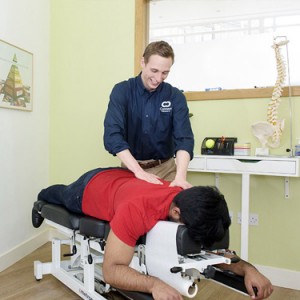 Back pain is a very common complaint. It can be very debilitating and is a major cause of time off work. In 2016/17, a total of 3.2 million working days were lost due to musculoskeletal disorders mainly affecting the back (Health & Safety Executive Nov 2017). Our modern lifestyle and often a lack of activity doesn’t help the problem. Sadly a lot of people simply put up with a stiff and occasionally painful back thinking it’s just ‘one of those things’, ‘I slept funny’ or ‘maybe it’s because I am getting older’. Lots of people don’t even notice how stiff their back is becoming because in their day to day routine they don’t move enough to even notice it is a problem.
Back pain is a very common complaint. It can be very debilitating and is a major cause of time off work. In 2016/17, a total of 3.2 million working days were lost due to musculoskeletal disorders mainly affecting the back (Health & Safety Executive Nov 2017). Our modern lifestyle and often a lack of activity doesn’t help the problem. Sadly a lot of people simply put up with a stiff and occasionally painful back thinking it’s just ‘one of those things’, ‘I slept funny’ or ‘maybe it’s because I am getting older’. Lots of people don’t even notice how stiff their back is becoming because in their day to day routine they don’t move enough to even notice it is a problem.
People with sudden, acute back pain often think, ‘But gosh, I didn’t even do anything!’. What many people don’t know, or understand, is that it’s not always a case of what you did five minutes ago, or what you did yesterday, or even what you did last week that’s causing the current symptoms. It’s most often cumulative until that ‘straw that broke the camel’s back’ episode.
Of the main types of stress that affect the body – primarily emotional, chemical and physical – the physical stress is often the most obvious cause which leads to areas of the spine not moving correctly and nerve irritation. Physical stressors can be from many types but usually are from injuries or repetitive strain. Current injuries are fairly obvious, but clients often forget injuries from years ago or significant injuries when they were a child. Repetitive strain, like sitting, especially with poor posture, associated with using computers and mobiles is the modern epidemic. These stressors accumulate to the point where the resilience of the body to adapt is overloaded and this may cause abnormal neurological control of muscles. This may lead to strained joints and ‘pulled’ muscles.
Beating Back Pain
The best way to stay on top of things so you don’t end up with chronic or acute back pain is to live a healthy lifestyle – such as eat healthy foods, take regular exercise and stretches, practice good posture when standing and sitting (and don’t sit for too long without getting up and taking regular breaks), take care when lifting, sleep at least eight hours each night on a mattress that supports you, and learn how to manage your stress. Seeking regular chiropractic care can also really help your body to heal, be more resilient and get relief from back pain.
Unfortunately a lot of people take pain relieving medication regularly for back pain when there are often other more natural options available. Pain relief medication may be useful in the very short term but longer term it usually doesn’t really help address the underlying problem, nor answer the key questions of ‘why did this happen’, ‘why did this happen again’ or ‘what can I do about this long term’? A recent series of research papers from The Lancet (Low Back Pain March 2018) said there should be less emphasis placed on the role of medication and surgery for the epidemic of back pain.
As chiropractors we want to keep our intervention as natural as possible because healing is an inside out and usually not an outside in affair. A simple example of this is if you cut yourself the skin usually heals without any external help. For most people it’s this healing energy within your body that we think gets blocked, allowing back symptoms to start (often without injury!), keep reoccurring or more annoyingly stay around for an extended period of time.
A lot of people try body movement training like yoga and pilates to improve spinal function and reduce symptoms. They often think their symptoms are because of a common belief of weak core muscles or the perception of a weak or perhaps inflexible spine. These classes can help but very often we find that people still don’t get to the root of the problem of why they are getting the symptoms. Physiologically tight muscles often guard and protect the body, so we suggest people look beneath and find out what the muscles are guarding. Often it is poorly moving joints which cause changes to the function of the nervous system and result in muscle contraction. We regularly see our new clients that already participate in yoga and pilates report that many aspects of their performance during the classes improves following chiropractic care, making the classes easier and more rewarding.
Chiropractic Care and Low Back Pain
 Chiropractors get your nervous system functioning better by primarily improving the function of your spine. We do this through a series of chiropractic treatments or as we like to call them ‘adjustments’. Adjustments generally improve the connection between your brain and your body, allowing your body to function better and start to heal naturally. Chiropractic treatment is based on scientific evidence and it works. If you’ve never thought of going to see a chiropractor, perhaps give it a try. We often provide our clients with a different perspective on the cause of their symptoms than that offered by your GP or a physio. A quick online search will show you where your local chiropractor is. All Chiropractors in the UK must be registered by the General Chiropractic Council.
Chiropractors get your nervous system functioning better by primarily improving the function of your spine. We do this through a series of chiropractic treatments or as we like to call them ‘adjustments’. Adjustments generally improve the connection between your brain and your body, allowing your body to function better and start to heal naturally. Chiropractic treatment is based on scientific evidence and it works. If you’ve never thought of going to see a chiropractor, perhaps give it a try. We often provide our clients with a different perspective on the cause of their symptoms than that offered by your GP or a physio. A quick online search will show you where your local chiropractor is. All Chiropractors in the UK must be registered by the General Chiropractic Council.
At Connect Chiropractic we treat low back pain by developing a care plan that is bespoke for your needs. Your first appointment will involve an examination that will include diagnostic testing for posture, muscle tension and stress levels. We look at the whole of you because everything in your body is connected. It generally doesn’t make sense to only just focus on the part of your spine or your body that is symptomatic. Treatment may include gentle specific manipulation of spinal joints to release tension and encourage correct nerve activity. We’ll give you home tips and advice to help you heal quicker and keep you more resilient to the stresses of modern life.
Don’t suffer back pain. In most cases you don’t have to.
